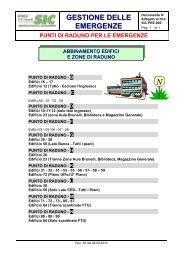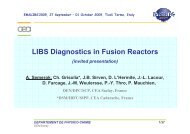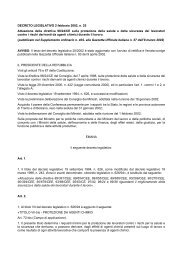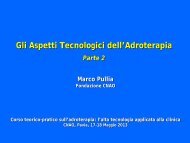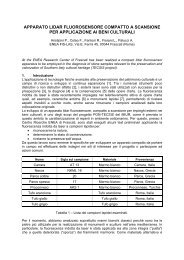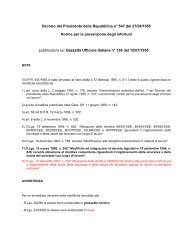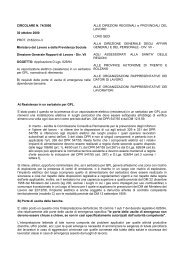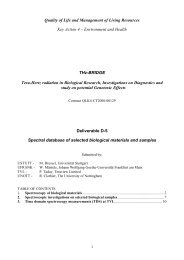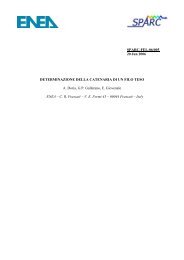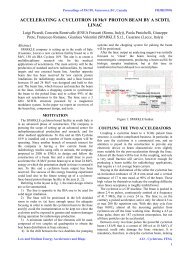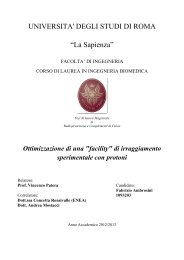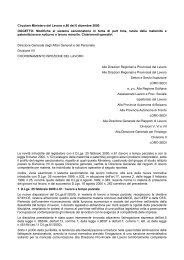Theory, Design and Tests on a Prototype Module of a Compact ...
Theory, Design and Tests on a Prototype Module of a Compact ...
Theory, Design and Tests on a Prototype Module of a Compact ...
Create successful ePaper yourself
Turn your PDF publications into a flip-book with our unique Google optimized e-Paper software.
iv INTRODUCTION<br />
In the state <strong>of</strong> art <strong>of</strong> the linear accelerator design, many aspects<br />
are involved: the theoretical design, the numerical design <str<strong>on</strong>g>and</str<strong>on</strong>g> the experimental<br />
verificati<strong>on</strong>, namely the radi<strong>of</strong>requency measurement. In<br />
this thesis all the aspects are covered, sometimes with less details <str<strong>on</strong>g>and</str<strong>on</strong>g><br />
sometimes with more. This is due to the own nature <strong>of</strong> the work. It<br />
was developed during the effective design <str<strong>on</strong>g>and</str<strong>on</strong>g> c<strong>on</strong>structi<strong>on</strong> <strong>of</strong> the module,<br />
up to all the practical details a c<strong>on</strong>structi<strong>on</strong> needs, <str<strong>on</strong>g>and</str<strong>on</strong>g> for time<br />
reas<strong>on</strong>s, sometimes the more known classical techniques were preferred.<br />
Nevertheless, several scientific ideas have come out in sight <strong>of</strong> an industrial<br />
producti<strong>on</strong>s <strong>of</strong> LIBO. First, the possibility to apply engineering<br />
criteria to the design; then, the possibility to have automatic measurement<br />
which should not need high qualified human c<strong>on</strong>tributi<strong>on</strong>. All<br />
these points are stressed where it is the case.<br />
Finally, we would spend some words about the agencies involved in<br />
this project. First the TERA Foundati<strong>on</strong>, directed by Pr<strong>of</strong>. U. Amaldi,<br />
where the first ideas were born. Then, the CERN in Geneva, where<br />
the most part <strong>of</strong> the c<strong>on</strong>structi<strong>on</strong> <str<strong>on</strong>g>and</str<strong>on</strong>g> measurement has been made <str<strong>on</strong>g>and</str<strong>on</strong>g><br />
where the project team was used to gather (the author has been spent<br />
almost the half part <strong>of</strong> his PhD at CERN). Next, INFN Sez. di Milano<br />
e Napoli who gave m<strong>on</strong>ey <str<strong>on</strong>g>and</str<strong>on</strong>g> people to work <strong>on</strong> this project, <str<strong>on</strong>g>and</str<strong>on</strong>g> last<br />
but not least, the Dipartimento di Ingegneria Elettrica in Naples that<br />
has a good traditi<strong>on</strong> in accelerator development <str<strong>on</strong>g>and</str<strong>on</strong>g> where the author<br />
has the privilege <strong>of</strong> doing his PhD.<br />
In the first chapter a short introducti<strong>on</strong> to the hadr<strong>on</strong>therapy is<br />
presented with a descripti<strong>on</strong> <strong>of</strong> the main medical centers in the world<br />
that use hadr<strong>on</strong>therapy.<br />
In the sec<strong>on</strong>d chapter, we deal with an introducti<strong>on</strong> to the linear<br />
accelerator, with the definiti<strong>on</strong> <strong>of</strong> the main parameters involved <str<strong>on</strong>g>and</str<strong>on</strong>g> the<br />
characteristics <strong>of</strong> coupled cavities. Particular emphasis is paid to the<br />
side coupled structure. In this chapter it is also presented LIBO structure<br />
with the radi<strong>of</strong>requency, beam dynamic <str<strong>on</strong>g>and</str<strong>on</strong>g> mechanical aspects<br />
stressed as well.<br />
In the third chapter the effective radi<strong>of</strong>requency design <strong>of</strong> a side<br />
coupled linac with a top-down methodology is shown. All the aspects<br />
are covered: from the first numbers involved, up to the definiti<strong>on</strong> <strong>of</strong> the<br />
single cavities details, while in the fourth chapter a circuit model is<br />
presented which has the aim to give the sensitivity <strong>of</strong> the main parameters<br />
to mechanical tolerances. Numerical results are shown as well.<br />
In the last chapter a detailed descripti<strong>on</strong> <strong>of</strong> radi<strong>of</strong>requency measurement<br />
<strong>on</strong> the prototypes is illustrated. Some innovative approaches<br />
are presented <strong>on</strong> the measurement <strong>of</strong> coupled cavities <str<strong>on</strong>g>and</str<strong>on</strong>g> a flux diagram<br />
<strong>of</strong> both mechanical <str<strong>on</strong>g>and</str<strong>on</strong>g> measurement procedure is commented.



